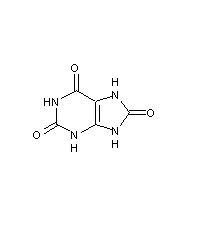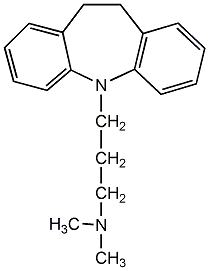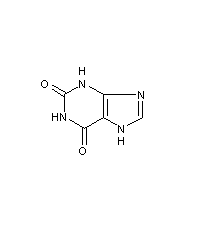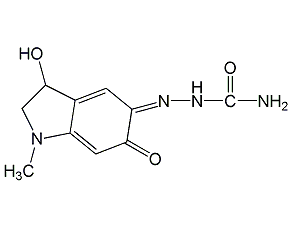
Structural formula
| Business number |
01FW |
| Molecular formula |
C5H4N4O3 |
| Molecular weight |
168.11 |
| label |
7,9-dihydro-2,6,8(3H)trione-1H-purine,
2,6,8,-trihydroxyurine heterocycle,
purine trioxide,
2,6,8-Purinetrione,
2,6,8-Trihydroxypurine,
8-Hydroxyxanthine,
2,6,8-Trioxopurine,
Reagents for determination of uricase and tungstate
|
Numbering system
CAS number:69-93-2
MDL number:MFCD00005712
EINECS number:200-720-7
RTECS number:YU7050080
BRN number:156158
PubChem number:24900634
Physical property data
1. Properties: white crystal, odorless. 2. Density (g/mL, 25/4℃): 1.9
3. Relative vapor density (g/mL, air=1): Uncertain
4. Melting point (ºC):> 300
5. Boiling point (ºC, normal pressure): Uncertain
6. Boiling point (ºC, 5.2kPa): Uncertain
7. Refractive index : Uncertain
8. Flash point (ºC): Uncertain
9. Specific rotation (º): Uncertain
10. Autoignition point or Ignition temperature (ºC): Uncertain
11. Vapor pressure (kPa, 25ºC): Uncertain
12. Saturated vapor pressure (kPa, 60ºC): Uncertain
p>
13. Heat of combustion (KJ/mol): Uncertain
14. Critical temperature (ºC): Uncertain
15. Critical pressure (KPa): Uncertain Determine
16. The logarithmic value of the oil-water (octanol/water) partition coefficient: Uncertain
17. The upper limit of explosion (%, V/V): Uncertain
18. Lower explosion limit (%, V/V): Uncertain
19. Solubility: Soluble in hot concentrated sulfuric acid, glycerol, alkali solution, sodium acetate and sodium phosphate solutions. Hardly soluble in water, insoluble in alcohol and ether.
Toxicological data
Breeding: rat oral TDLo: 5040 mg/kgSex/duration: male 4 week(s) pre-mating; mutagenicity: human lymphocyte Mutation test systems – not otherwise specifiedTest system: 10 mmol/L;
Ecological data
General remarks
Water hazard level 1 (German regulations) (self-assessment via list) This substance is slightly hazardous to water.
Do not allow undiluted or large quantities of product to come into contact with groundwater, waterways or sewage systems.
Do not discharge materials into the surrounding environment without government permission.
Molecular structure data
None
Compute chemical data
1. Reference value for hydrophobic parameter calculation (XlogP): -1.9
2. Number of hydrogen bond donors: 4
3. Number of hydrogen bond acceptors: 3
p>
4. Number of rotatable chemical bonds: 0
5. Number of tautomers: 43
6. Topological molecule polar surface area 99.3
7. Number of heavy atoms: 12
8. Surface charge: 0
9. Complexity: 332
10. Number of isotope atoms: 0
11. Determine the number of atomic stereocenters: 0
12. Uncertain number of atomic stereocenters: 0
13. Determine the number of chemical bond stereocenters: 0
14. Number of uncertain chemical bond stereocenters: 0
15. Number of covalent bond units: 1
Properties and stability
Heated to above 400℃, it decomposes into hydrocyanic acid without melting, so it cannot be subjected to strong heat.
Storage method
Packed tightly in brown wide-mouth glass bottles. Store in a cool and dry place
Synthesis method
1. Suspend dry chicken manure in 24 times the amount of water, add an appropriate amount of calcium hydroxide and let it stand. After the precipitation is complete, separate the supernatant, add water to the precipitation, adjust the pH value to 3 with nitric acid, and let it stand until the precipitation is complete. Separate the supernatant, resuspend the precipitate in water, adjust the pH value to 12-12.5 with calcium hydroxide, adjust the pH value of the filtrate to 3 with nitric acid after filtration, and filter and dry the precipitate to obtain crude uric acid.
Purpose
1. Reagents that can be used to measure uricase and tungstate. Uric acid and its derivatives have no side effects on the skin and are used in cosmetics for various conditioning functions. It has significant moisturizing properties, can treat skin dysfunction, has antioxidant properties, can delay skin aging and prevent skin cancer.
2. It can treat excessive dandruff. Adding 0.001% to hair care products can effectively inhibit dandruff.
extended-reading:https://www.bdmaee.net/dichlorodioctylstannane/extended-reading:https://www.newtopchem.com/archives/1089extended-reading:https://www.bdmaee.net/acetic-acid-potassium-salt/extended-reading:https://www.bdmaee.net/aeea/extended-reading:https://www.bdmaee.net/octyltin-oxide/extended-reading:https://www.bdmaee.net/wp-content/uploads/2022/08/17.jpgextended-reading:https://www.bdmaee.net/niax-bdma-liquid-tertiary-amine-catalyst-momentive/extended-reading:https://www.newtopchem.com/archives/1066extended-reading:https://www.cyclohexylamine.net/low-odor-reaction-type-9727-catalyst-9727/extended-reading:https://www.bdmaee.net/wp-content/uploads/2022/08/37.jpg









